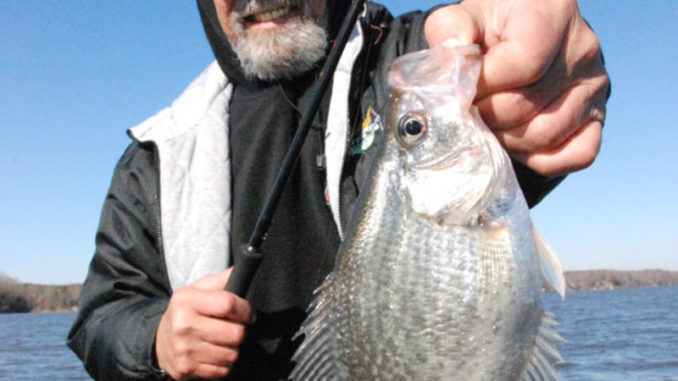
Get a jump on Carolina crappie season on any level in February
Crappie fishermen who can’t wait for the start of crappie season would be wise to go ahead and hit the lake rather than wait for the dogwoods to bloom. February is a great month to catch a cooler full of slabs if you understand how fish behave during the coldest part of the year as well as where they prefer to wait out the end of the winter before settling into their prespawn patterns.
If you need help with finding a pattern, try one of these tactics to help you locate and catch crappie anywhere in the water column.
Surface slabs
Stokes McClellan of Huntersville, N.C., is a diehard fisherman who loves to long-line troll for crappie. Many anglers are slow-trolling for cold-water fish. But McClellan discovered a pattern with big crappie holding in extremely shallow water under specific conditions in February.
McClellan explained that water temperatures in February tend to be static throughout the water column. One exception is on particularly bright, calm days when the sun hitting the water will raise the surface temperature by several degrees by mid-afternoon.
“I discovered this by mistake,” McClellan said. “I was slow-trolling one area, and rather than crank up, I simply put the trolling motor on high and crossed the lake with the jigs still out behind the boat.”
Circle back when you catch a surprise crappie
Much to his surprise, he caught a big slab right on the surface over water that was 30 to 40 feet deep. He circled back and caught another one, then another one. He finally decided he must be on to something.
“The water was extremely calm, and I figured the crappie were laying up on the surface so shallow you’d think you’d see their fins sticking out of the water,” he said. “I’ve since talked to other anglers who have experienced the same thing. The fish are up sunning, laying in that very upper layer because it’s warmer than the surrounding water.”
McClellan refined the tactic and discovered that between 1.5 and 2.0 mph is the best trolling speed. Because running over the fish with the boat spooks them, he suggests using the longest rods available. This keeps baits away from the boat. And he makes sweeping turns. He also uses tiny, 1/64-ounce jigs with buoyant rubber bodies.
“People think I’m crazy, speeding along with the jigs almost skipping across the top of the water, but those crappie are there, and over some real deep water, and the way to catch them is to keep that jig right on top,” he said.
Bring on the rain
Rod Wall of Ninety Six, S.C., loves to troll for crappie in February, particularly after a winter rain.
“I fish Clarks Hill, Santee and Lake Greenwood the most,” Wall said. “Anytime we get runoff that makes the water dingy, I know the crappie are going to get up out of the brush and suspend somewhere in the middle of the water column.”
Using his electronics, Wall will run most of the way back into tributary creeks and scan for baitfish on either side of his boat, He pays particular attention to the depth where he marks both bait and fish.
“If there’s bait there, the fish will be in there too,” he said. “I want good, olive-colored water that brings them off the bottom. Then, it’s just a matter of long-lining jigs behind the boat, adjusting them to the proper depth and go.”
Wall said crappie can show a specific preference for colors late in the winter. He mixes and matches jigheads and body colors on the eight to 12 crappie poles he uses until he catches a fish. He continues switching colors until he hones in on the hot color of that day. Then he will change all of his lines to that color.
“Color is important, but you’ve also got to be pulling slightly above the eye level of the fish. Crappie seldom go down to eat a bait. You want to be right at eye level or just above, because they won’t chase it very far up when the water is still cold,” he said.
Mine the bottom for black crappie
Joey Mines, a fishing guide from LaGrange, Ga., has been host of one of the longest-running outdoor TV shows. Back in the day, he discovered a winter pattern for catching black crappie when water temperatures are under the 50-degree mark.
“I’m looking for lumps on the bottom in water depths of 10 to 25 feet,” he said. “Most anglers who see these fish never give them a second thought, thinking they’re something else because they aren’t holding on anything — no creek channel, no stumps, no brush piles — they’re just on the bottom. What they are seeing are small schools of crappie.”
One possible explanation is that female crappie lay in the mud during the early prespawn to facilitate egg production. Another suspicion is it’s simply warmer laying in the mud on the bottom. Mines doesn’t disagree with either idea.
Mark the fish, then catch ’em
“All of these fish are black crappie, and the vast majority are egg laden females and they’ll have mud stained bellies from laying on the bottom,” he said.
To catch these fish, Mines first marks them with a throwable buoy. He then positions his boat right over them. He looks for nearly windless days so he can more easily keep his boat in place. Then, he puts several rods in rod holders. He puts his live baits just off the bottom using a drop-shot rig.
“I rig this with a ½-ounce weight on the bottom and a dropper with a No. 2 hook about 18 inches above the weight,” he said. “The bait is a small live minnow. It’s got to be lively so the fish can find it; they won’t move much to eat it.”
Using a limber, 12-foot crappie pole, Mines will tighten the line until the rod has a bow in it. Then he looks for the slightest wobble to indicate a crappie has gently inhaled the bait.

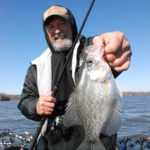
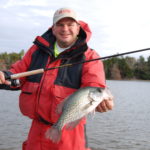
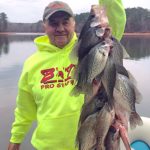
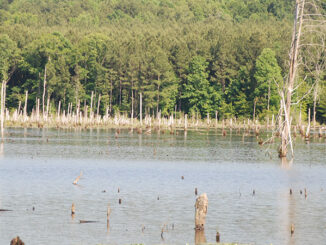
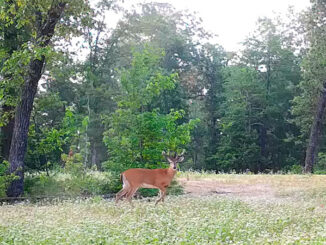


Be the first to comment